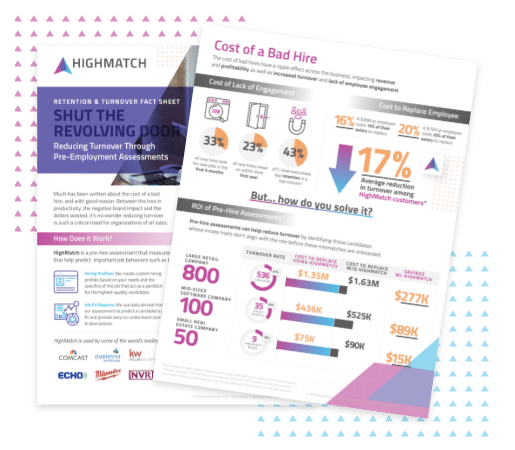HighMatch Guides
How to reduce employee turnover
Employee turnover can be a significant challenge for businesses, impacting productivity, morale, and overall organizational success. To address this issue effectively, it is essential for organizations to understand the true cost of their turnover and retention challenge, identify the underlying reasons behind those and then pursue and prioritize strategies aimed at reducing turnover and improving employee retention.
Understanding the hidden costs of employee turnover
Employee turnover is a common challenge faced by businesses of all sizes and industries. When employees leave a company, it can lead to significant disruptions and financial implications that may not always be immediately apparent. The true cost of employee turnover extends beyond the recruitment and onboarding expenses, encompassing lost productivity, reduced morale, and decreased organizational effectiveness.
It’s critical for organizations to understand their current turnover rate and attempt to quantify the costs associated with turnover to build support across the organization for addressing the underlying issues. By defining their turnover rate and associating that number with hard costs to the business, HR teams can make strong business cases for funding initiatives to address these issues.
When calculating the costs of employee turnover, it’s important to keep in mind the following:
1. Recruitment and Hiring Costs:
Recruiting and hiring new employees can be a time-consuming and expensive process. The cost of job advertisements, recruitment agency fees, and background checks can add up quickly. According to a study by the Society for Human Resource Management (SHRM), the average cost-per-hire for companies is approximately $4,129 (SHRM, 2016). This figure may vary depending on the level of the position and the industry.
2. Onboarding and Training Expenses:
When a new employee joins a company, they require proper onboarding and training to be effective in their roles. Investing in orientation programs, training materials, and resources takes both time and money. A report by the Association for Talent Development (ATD) found that companies spend an average of $1,296 per employee on training and development (ATD, 2021).
3. Loss of Productivity:
During the period between an employee’s departure and the hiring of a replacement, there is a loss of productivity. Existing employees may have to take on additional tasks, leading to potential burnout and decreased efficiency. The Center for American Progress estimates that the cost of lost productivity due to employee turnover can range from 16% to 213% of the departing employee’s salary (Center for American Progress, 2012).
4. Impact on Company Morale:
High turnover rates can negatively impact the morale and motivation of remaining employees. They may feel uncertain about their future with the company and question its stability. A study conducted by Gallup found that companies with higher employee turnover rates experience lower levels of employee engagement (Gallup, 2017).
5. Customer Satisfaction and Quality of Service:
In customer-facing roles, frequent turnover can lead to a decline in the quality of service provided to customers. New employees may take time to adapt to the company’s values and processes, potentially affecting customer satisfaction levels. Research published in the Journal of Services Marketing highlights the strong relationship between employee turnover and customer satisfaction (Boselie et al., 2005).
6. Loss of Institutional Knowledge:
Experienced employees possess valuable institutional knowledge and expertise that may be lost when they leave. This knowledge is often essential for maintaining operational efficiency and can take time for new hires to acquire. A report by the Work Institute estimates that the cost of losing an employee is approximately 33% of their annual salary in terms of lost knowledge and productivity (Work Institute, 2020).
Considering an assessment solution but need help building a business case to fund it? Check out the HighMatch ROI calculator, which will help you calculate your turnover rate and potential savings as a result of implementing a HighMatch personalized assessment.
Root causes and strategies for retention
Employee turnover is a persistent challenge that businesses face across industries and sectors. It refers to the rate at which employees leave an organization voluntarily or involuntarily over a given period. High turnover rates can disrupt workflow, impact productivity, and incur substantial costs for recruitment and training.
To address this issue effectively, it is essential for companies to identify the underlying reasons behind employee turnover. Reasons include:
1. Lack of Career Growth and Development Opportunities:
Employees are more likely to seek new opportunities if they feel their current roles offer limited prospects for growth and advancement. A study by Gallup reveals that 87% of millennials consider career growth opportunities as crucial factors in their job satisfaction (Gallup, 2016). Companies that fail to provide clear paths for professional development risk losing their top talent to organizations that offer more promising career trajectories.
2. Inadequate Work-Life Balance:
The modern workforce values a healthy work-life balance, and companies that do not prioritize this aspect may experience higher turnover rates. Long working hours, unrealistic expectations, and a lack of flexible work arrangements can lead to burnout and dissatisfaction. Research published in the Journal of Vocational Behavior highlights the link between work-life balance and employee turnover intentions (Demerouti et al., 2004).
3. Poor Management and Leadership:
Supervisors play a pivotal role in employee satisfaction and retention. Employees who have strained relationships with their managers or feel unsupported by leadership are more likely to seek employment elsewhere. A study by HBR found that 58% of employees said they would trust a stranger more than their own boss (HBR, 2017). In contrast, strong leadership and supportive management can foster loyalty and reduce turnover.
4. Inadequate Recognition and Reward Systems:
Recognition and rewards are essential for employee motivation and job satisfaction. When employees feel undervalued or believe their efforts go unnoticed, they may seek recognition elsewhere. A survey conducted by Globoforce and SHRM revealed that 82% of employees feel that recognition and appreciation for their work are vital (SHRM, 2019).
5. Compensation and Benefits Disparities:
Employees are more likely to stay with a company that offers competitive compensation packages and benefits. If they perceive that their compensation is not in line with industry standards or that they are not receiving fair remuneration for their efforts, they may consider alternative job opportunities. A survey by Glassdoor found that 45% of employees consider salary and compensation as the primary driver of job satisfaction (Glassdoor, 2019).
6. Limited Opportunities for Skill Utilization:
Employees seek roles where they can apply their skills and knowledge effectively. When they feel their skills are underutilized or not aligned with their job responsibilities, they may become disengaged and look for opportunities that better leverage their expertise. A study published in the Journal of Applied Psychology suggests that skill utilization is significantly related to job satisfaction and intent to leave (Kristof-Brown et al., 2005).
Employee turnover is a multi-faceted issue influenced by various factors. Companies must recognize that it is not solely about attracting new talent but also about retaining their existing workforce. By addressing the root causes of turnover, such as providing career growth opportunities, promoting work-life balance, fostering strong leadership, implementing effective recognition systems, and offering competitive compensation packages, organizations can create a work environment that promotes employee loyalty and reduces turnover rates.
Tips for reducing turnover and enhancing employee retention
High turnover rates not only lead to increased recruitment and training costs but also result in a loss of valuable expertise and company knowledge. To combat this issue, companies must prioritize strategies aimed at reducing turnover and improving employee retention.
Some proactive ways organizations can help reduce employee turnover and increase retention include:
1. Foster a Positive Company Culture:
A positive company culture is the backbone of a satisfied and engaged workforce. Companies should strive to create an inclusive, supportive, and respectful environment where employees feel valued and appreciated. Celebrate achievements, provide recognition, and encourage open communication at all levels of the organization.
2. Invest in Employee Development:
Offer opportunities for professional growth and development. Support employees in attending workshops, conferences, and training programs. Investing in their skill enhancement not only benefits the individual but also improves their contribution to the company.
3. Competitive Compensation and Benefits:
Review the company’s compensation structure regularly to ensure it aligns with industry standards. Additionally, consider offering competitive benefits packages, such as health insurance, retirement plans, and flexible work arrangements, to attract and retain top talent.
4. Provide Regular Feedback and Performance Reviews:
Establish a performance review system that provides constructive feedback and acknowledges employee achievements. Regular check-ins between employees and their managers can identify and address concerns before they escalate.
5. Offer Work-Life Balance:
Promote a healthy work-life balance by encouraging employees to take time off when needed and implementing flexible work schedules where possible. A balanced life leads to increased job satisfaction and reduced burnout.
6. Create Clear Career Paths:
Outline clear career advancement opportunities within the organization. Employees are more likely to stay with a company that offers a path for growth and professional development.
7. Strengthen Leadership and Management Skills:
Equip managers with strong leadership and communication skills. A supportive and empathetic management style fosters a positive relationship between employees and their supervisors.
8. Conduct “Stay” Interviews:
While exit interviews are common, consider conducting “stay” interviews with current employees. Ask them about their job satisfaction, areas for improvement, and what motivates them to stay with the company.
9. Encourage Employee Engagement:
Organize team-building activities, social events, and employee engagement programs. Engaged employees are more likely to be committed to their work and the company’s mission.
10. Recognize and Reward Hard Work:
Implement a recognition and rewards program to acknowledge outstanding performance and efforts. Publicly recognize employees’ achievements to boost morale and motivation.
11. Support Mental and Physical Well-being:
Promote wellness initiatives that prioritize employees’ mental and physical health. Offer resources such as counseling services, wellness programs, and gym memberships.
12. Embrace Diversity and Inclusion:
Create a diverse and inclusive workplace that respects and values individual differences. Embracing diversity fosters creativity, innovation, and a broader range of perspectives.
13. Foster a Sense of Belonging:
Ensure that all employees feel included and part of a larger team. Create a sense of belonging and camaraderie within the workplace.
14. Exit Interview Analysis:
Analyze data from exit interviews to identify recurring issues leading to turnover. Use these insights to make necessary improvements within the organization.
15. Promote Internal Mobility:
Encourage employees to explore opportunities within the company. Internal promotions not only motivate employees but also demonstrate the organization’s commitment to career growth.
Reducing turnover and improving employee retention requires a comprehensive approach that addresses various aspects of the work environment and employee experience.
16. Implement a Personalized Assessment
Implementing a pre-employment assessment, which helps identify those candidates who align best with the role and company culture, can help ensure new hires are likely to be happy and successful in the role and fit in well with your existing employees. Personalized assessments, built by I-O psychologists to measure what matters most in the role and in your culture, are best suited to reduce turnover, as they identify those unique qualities shared by your longest tenured employees and use those to filter your candidate pool.
By fostering a positive culture, supporting professional development, offering competitive compensation and benefits, and embracing diversity, companies can create a workplace where employees feel motivated, engaged, and committed for the long term. Employee retention is an ongoing process that requires continuous effort and adaptation to meet the ever-evolving needs of the workforce.
Summary
Investing in employee retention not only saves recruitment and training costs but also contributes to a more engaged and productive workforce, ultimately leading to long-term success for the company. HR professionals can lead the charge here by understanding and calculating the true cost of turnover, identifying the most likely root causes driving turnover in their organization and identifying solutions, like personalized pre-employment assessments, that can help cost-effectively address these issues at scale.
Sources:
SHRM. (2016). Human Capital Benchmarking Report . SHRM
ATD. (2021). 2021 State of the Industry Report. TD.org
Center for American Progress. (2012). There Are Significant Business Costs to Replacing Employees. American Progress
Gallup. (2017). State of the American Workplace Report. Gallup
Boselie, P., Dietz, G., & Boon, C. (2005). Commonalities and contradictions in HRM and performance research. Human Resource Management Journal, 15(3), 67-94.
Work Institute. (2020). 2020 Retention Report. Work Institute
Gallup. (2016). How Millennials Want to Work and Live. Gallup
Demerouti, E., Bakker, A. B., Nachreiner, F., & Schaufeli, W. B. (2004). The job demands-resources model of burnout. Journal of Applied Psychology, 86(3), 499-512.
Harvard Business Review. (2017). The Boss Factor: Making the World a Better Place Through Workplace Relationships. HBR
SHRM/Globoforce. (2019). The Business Impact of Recognizing Employees. SHRM
Glassdoor. (2019). Job & Hiring Trends 2019. Glassdoor
Kristof-Brown, A. L., Zimmerman, R. D., & Johnson, E. C. (2005). Consequences of individuals’ fit at work: A meta-analysis of person-job, person-organization, person-group, and person-supervisor fit. Personnel Psychology, 58(2), 281-342.





